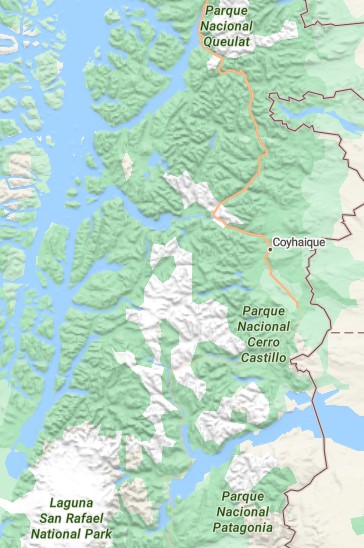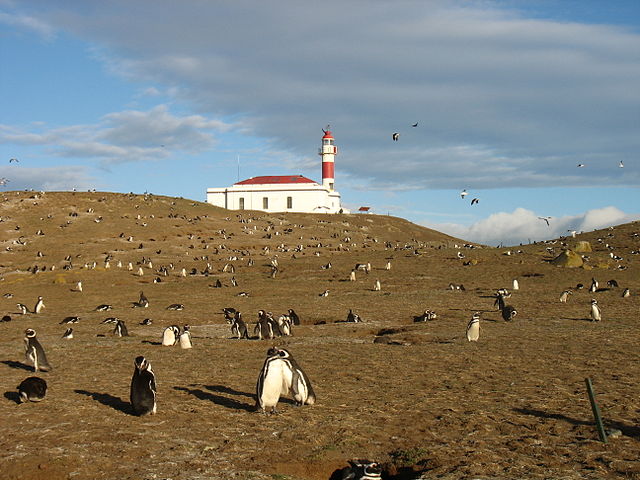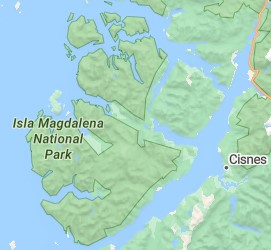A visit to Isla Magdalena is the most elusive of this entire park series, because it’s so unreachable, at least by land. The entire island is a park, but it has no trails. There are no park rangers, either. So, how do you visit it, and why would I even bother to talk about it?
The answer is yes, you can visit Isla Magdalena by water access only, meaning you can get to the small village of Puerto Gaviota on a ferry, but to visit the village only. Or, you can kayak around the island embarking from Puerto Cisnes, which is where we discussed in the last article in this series that you go to visit Park Queluat. By staying in Puerto Cisnes, you get two parks from one hub!
If at all possible, plan your visit for the first weekend in February, because that’s the annual fishing festival in Puerto Gaviota, so the village will be more alive with lots of outdoor cooking, and locals prepared to take you on trails of their own making.
If you haven’t yet read up on some of the foundations of the entire seventeen-park route, go back and check out my overview post so you can get oriented.
If you’re following this park series of articles, and going in the order presented, then the airport you will have gone through already is Puerto Montt.
However, if you’re starting your journey with this park, then you would be better to fly to Balmaceda. This is the airport that serves Coyhaique, Chile, which is closer to Puerto Cisnes.
Chaitén also has a small regional airport that you could fly to from either Puerto Montt or Balmaceda, but keep in mind you have to go through some extra legwork to negotiate flights there that would probably take long enough that you can get there faster by bus. And, once in Chaitén, you have to continue south by bus to Puerto Cisnes which takes another several hours, and buses may not operate every day of the week.
As there are no park services or infrastructure on Isla Magdalena, and only pure untouchable wilderness, there is no fee associated with getting close to it, nor permits required.
Do not confuse this with private fees for access, for example, a resident may charge a nominal fee for crossing their ancestral land if you are on the island on a private tour. Private kayak excursions also may charge a permit or licensing fee that is included in their package.

Coyhaique is the provincial capital and geographic center of the Aysén region, but it only makes sense to start there if you’re flying in to Balmaceda airport, as you’ll have to travel north from there to get to Puerto Cisnes, and then return the way you came to get to all the other parks in Aysén.
The majority of travelers interested in Isla Magdalena arrive to Puerto Cisnes by ferry, originating in Quellon (the southern tip of Isla Chiloe). The ferry is not only the most sensible, it’s the most enjoyable, and it allows you to either see Isla Magdalena from the deck as they have routes directly to Puerto Gaviota from Puerto Cisnes, or just to offboard in Puerto Cisnes and connect with kayaking tours that take just a couple hours of time.
For those who are hiking this series with me, you will already be in Puerto Cisnes or close by in Puyuhuapi, that you are already where you need to be to enjoy your visit to Isla Magdalena.


Open all year
Topography: Evergreen forest
Climate: Rainy and mild.
In a word, Penguins! The adorable birds love this island because it’s an officially protected sanctuary, but they also seem to get along well with kayakers and beachwalkers. Kayak excursions also treat travelers to close encounters with sea lions, and whales at certain times of the year, and the isolated village of Puerto Gaviota loves visitors coming on to shore for a stroll along their elevated boardwalk.
The kayak crossing from Puerto Cisnes across the Puyuhuapi channel takes about an hour, but there are several outfitters in town who can arrange longer, more rigorous adventures to other coasts of the island.

Other critters you might see popping in and out of the forest are otters and nutrias, and Commerson’s Dolphins also enjoy the fjords. If you want to get closer to the sea lions, you should ask your outfitter in Puerto Cisnes if they have an option to go the smaller islets of Santa Isabel and San Andrés.
The peak in the middle of the island is the Mentolat Volcano, which reaches an impressive height of 5,446 feet.
Having a plan to stay for a good three or four days in and around Puerto Cisnes is a good idea, as that will give you the best chances and opportunity to experience both Queulat and Isla Magdalena parks. Also, the ferries only come in and out of Puerto Cisnes (from Quellon, and to Puerto Chacabuco) a couple times per week, so use the ferry schedule as a way of setting your agenda. To follow the series, you don’t need to worry about the ferry schedule leaving Puerto Cisnes, as you will be taking the bus inland.
Your choices for visiting Isla Magdalena fall into two basic categories, and by default, they don’t mix. One choice is kayaking around the coastline of the island, seeing wildlife and birds. The other option is taking the ferry trip of about three hours to the village of Puerto Gaviota, which is less about wildlife and recreation and more about culture and fishing traditions. Ferries are one-way, however, meaning that the ferry getting you to Puerto Gaviota is not going back, so you would have to wait for a day or two for the ferry coming the other way in order to get back to Puerto Cisnes.
Still, with a local outfitter from Puerto Cisnes, of course anything is possible and they can arrange all kinds of visits that provide deeper access to the island and cultural visits with the indigenous Chono residents that are not generally available. The place is much more adaptable than you may at first believe.
A second strategy that is lighter on the thighs, is simply to stay on the ferry when you depart Quellón and only do shore excursions in Puerto Cisnes and Puerto Gaviota on your way to Puerto Chacabuco. This strategy allows you a few hours of time in each port of call, but you won’t be doing any hiking or kayaking, and you won’t be able to visit Queluat park that I covered in the previous article. But, you still could follow this strategy and work your way backwards and inland from Puerto Chacabuco to the other southern parks of the Aysén region that I’ll cover in the coming articles, as they’re equally accessible from the south (Chacabuco) as from the north (Cisnes).
Catching a ferry from Puerto Cisnes is only for those that are going to the annual festival in early February, or have made reservations to stay in the village for at least a full day waiting for the return ferry. The ferry does not stay long enough in port (only 30 minutes) to be able to get off for a meaningful visit and then back on board again.
Ferries departing Puerto Cisnes to Puerto Gaviota are on Thursdays at 15:10 (arriving in Gaviota at 18:00), and Sundays at 19:30 (arriving in Gaviota at 22:20). So practically speaking, if you want to see Puerto Gaviota in daylight hours, Thursday is the only choice.
Ferries going back the other direction from Puerto Gaviota to Puerto Cisnes are on Tuesdays at 00:50 (arriving in Cisnes at 3:40 a.m.), and Fridays at 18:50 (arriving in Cisnes at 21:40).
While this is technically not a visit “to the park”, the village of Puerto Gaviota has only 187 residents and is so isolated that it is swallowed up by the park on every side, so you still are in the park by just taking a few steps off the board walk.
Any and every hotel and other lodging in Puerto Cisnes will either have kayaks to rent or can point you to a trusted neighbor who takes visitors out on kayaking excursions. It is very informal, but they know what they’re doing as they do it all the time. You will also see along the shoreline streets signs that say “paseo en bote“, which simply means to go out on a short excursion on a boat. This is not necessarily kayaking, and not necessarily targeting Isla Magdalena park, so be careful to make yourself clear that you want to visit the island, and if kayaking is your planned recreation, also be clear that you used the word ‘kayak’ (it’s the same in Spanish as in English).
Your innkeeper will also be able to organize the larger excursions if you give them enough time, like a visit to farther reaches of the park, or even hiking up the Mentolat volcano with a private guide.
Since I believe you really should visit both Isla Magdalena and Queulat and not just limit yourself to one, my recommendation is to take the ferry from Quellón to Puerto Cisnes and lodge there at one of their several great hostels, hotels, or cabañas. But don’t just sit quietly in your room. Make your innkeeper a partner early and often in your plans, and think big. They will help you find local transportation, outfitting, introduce you to local guides, and tell you which trails or shores are better than others in the particular season of your visit.
Puerto Cisnes is a fantastic resource if you’re willing to be social and curious, and the locals will love you for it and make sure you get more than you imagined.
Once you’re done with your visit to Isla Magdalena, you will get on the bus from Puerto Cisnes to Coyhaique to visit Parque Nacional Cerro Castillo!
South America Buses (SAB) is the luxury channel of AndesTransit, the land travel transportation schedule and reservation hub preferred most by travelers to Latin America. SAB has a select team of distinguished travel experts who have dedicated themselves to research, document, and curate routes and carriers in South America that meet nothing short of the highest quality standards in land travel.
Other Links
Copyright © 2024 SouthAmericaBuses. All rights reserved.
